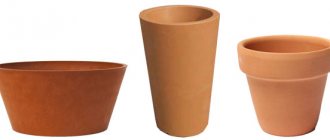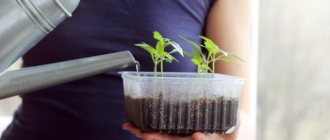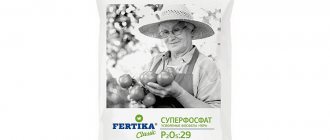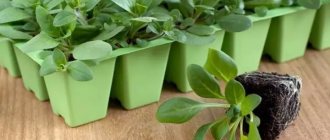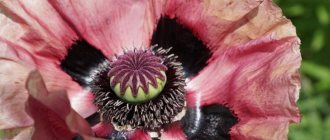Don’t know how to properly grow strong summer seedlings? Our article will help you avoid making mistakes and get a beautiful flower garden.
Using attractive annuals, you can create a bed of continuous flowering. To do this, the first step is to determine the optimal time for sowing seeds for seedlings. Plants that bloom within a couple of months after sowing (verbena, gatsania, lipweed, coleus, bluebell, pelargonium, sparkling salvia, fragrant tobacco, snapdragon, cineraria maritima) are sown in January-February. But mass sowing of annuals occurs in March and April.
Sowing dates for annual plants in central Russia
| Seed sowing time | Plant name |
| First half of March | Anemone, aster, anacyclus, seaside armeria, asparagus, adonis, Chinese carnation, gomphrena, kupena, kufeya, lacfiol, mirabilis, mesembryanthemum, euphorbia bordered, nolana, pyrethrum, sanvitalia, scabiosa, salpiglossis, platycodon, navel, helianthemum, aspen, primrose , soapwort, edelweiss, sage, immortelle. |
| Second half of March | Ageratum, arctotis, climbing azarina, brachycoma iberisolifolia, venidium, dianthus, helichrysum, godetia, dolichos, morning glory, cleome, lavatera, summer gillyflower, lobularia, nasturtium, nemesia, osteospermum, perilla, penstemon, Drummond's phlox, chrysanthemum, echinacea, echium. |
| First half of April | Arctotis, annual aster, basilisk, cottonweed, helipterum, iberis, kniphofia, xeranthemum, lobularia, fragrant mignonette, scabiosa. |
| Second half of April | Amaranth, marigolds, annual dahlia, datura, diascia, sweet pea, ornamental cabbage, clarkia, purslane, celosia, zinnia. |
How much water is needed for irrigation
It is impossible to say exactly how much water seedlings need, but you can determine experimentally how much water is needed specifically for your soil. To do this, you need to take several identical cups and fill them with earthen mixture. Be sure to fill the glass as tightly as when planting plants. Apply soil at a slightly lower level than your seedlings, about 1-1.5 cm.
Place the cups in a small tray and pour water into it using a measuring cup, for example, 200 grams. Pour 200 g and wait until all the water is absorbed. And so on until the soil is wet to the very top. If there is any water left in the pan, pour it into a measuring cup.
By carrying out simple arithmetic operations (subtract the remaining water from the total amount of water and divide the resulting result by the number of cups), you can calculate how much water is needed to saturate your particular soil in your cup. You can also estimate by volume, i.e. The cups are twice as large and will consume twice as much water.
This may be necessary for very novice gardeners who are afraid to overwater their plants (and rightly so).
Containers for flower seedlings
It is best to grow flower seedlings in separate pots, so as not to have to pick seedlings later. Such seedlings grow stronger and, as a rule, are not affected by rot.
Both small disposable cups and large boxes are suitable as containers for flower seedlings. The main thing is that there are holes made in the bottom of the container to drain excess water, and there is also a tray.
Seedlings of compact plants can also be grown in peat tablets or peat humus cups
How to prepare seeds for sowing
The quality of seedlings directly depends on the planting material. To grow good seedlings, you need to choose quality seeds. Before sowing, the seeds are prepared for germination. It is equally important to prepare them for the first difficulties - temperature changes, diseases, pest attacks. The procedure is carried out simultaneously. First, prepare a weak solution of potassium permanganate, add a little boric acid and place the seeds of annual plants there. The first time the seeds are soaked in the room for 10-12 hours. Then they are placed in the refrigerator for 12 hours. The procedure is repeated until the seeds hatch.
Seedlings of many annual, biennial and perennial plants germinate slowly, so you need to start sowing seeds of some flowers in winter. In February, seedlings of petunias, violas, and salvias are sown. In March, primroses, asters, phlox, dahlias, cloves, and castor beans are sown. And in April you can grow seedlings of flowers that develop and sprout well - ageratum, marigolds, iberis, zinnia.
Soil for seedlings
Under no circumstances should you use soil in which indoor or container plants have already grown. For seedlings it is necessary to take new soil. If you want to save money, you can prepare the soil mixture yourself. At the same time, do not forget to disinfect it: heat it in the oven for an hour at 50°C.
The substrate for seedlings of most annuals should consist of turf and leaf soil, humus and sand, taken in equal proportions. Only some crops require a different soil composition. For example, for flowers susceptible to the formation of blackleg (ageratum, aster, gillyflower, lobelia, snapdragon, petunia, fragrant tobacco), you need soil that contains turf soil, peat and sand in a ratio of 3:1:1.
Comfortable temperature
Growing flower seedlings depends not only on the seeds and soil, but also on the temperature of the room in which the boxes with the crops are located. Most flowers will sprout vigorously at 18-20 degrees Celsius; there are plants for which the comfortable temperature for sprouting is lower:
- 8-12 degrees – snapdragon
- 12-15 degrees - ageratum, godicia, shower. peas
- 15-16 degrees - aster, left-handed
- 15-18 degrees - viola, carnation.
Watering
After sowing, small seeds are sprayed with a spray bottle, larger ones are watered with a small watering can. The soil should not be washed away. To water the crops, we use settled tap water at room temperature.
Sowing seeds for seedlings
Place drainage made of expanded clay, gravel or broken brick 1 cm thick at the bottom of the container. Then place a moist (but not too wet!) substrate so that about 2 cm remains to the top of the container.
Sow large seeds in pre-made furrows to a depth equal to three times the size of the seed, and lightly compact the soil. Sow medium-sized seeds in the furrows, but only lightly sprinkle them with soil (the layer should not exceed 0.5 cm). Mix very small seeds with dry sand, scatter them over the surface of the soil and water them with a spray bottle.
Cover the container with glass or plastic wrap and place in a warm place. Please note: until seedlings appear, the soil should always be slightly moist.
The optimal temperature for germination of seeds of heat-loving plants is 25-30°C, cold-resistant plants are 15-18°C
After germination, remove the glass or film and keep the plants at a temperature of about 20°C. When the seedlings grow up, sprinkle their stems a little with light soil and place the plants in a well-lit place with a temperature of 15°C.
Fertilizers and stimulants
When the first two leaves appear, not counting the leaf from the seed, watering should be done with water with the addition of a small dose of special liquid mineral fertilizers for seedlings. In accordance with the instructions, add the required amount of fertilizer to the water using a graduated syringe.
If you see that the stems are stretching, immediately add additional light and apply fertilizer with calcium. If the seedlings suddenly turn yellow, apply fertilizing containing iron.
Landing dates
The process of growing seedlings of flowers and vegetables is similar and is necessary in order to obtain early flowering or early vegetables. The following flowers are grown in seedlings: snapdragons, ageratum, marigolds, aster, sweet peas, salvia, sweet tobacco, nasturtium, petunia, dahlia, purslane, annual phlox Drummond, poppies, etc. Early seedlings are planted in late January - early February, then after 10-12 weeks, flowers will appear in early May.
Containers for sowing
Currently, specialized stores have a sufficient selection of containers for seedlings, but they are all too deep for planting seeds and require a large amount of soil.
Some gardeners use plastic cat trays and other various shallow plastic containers for planting seeds.
After diving, when each root is transplanted individually, deeper pots are needed. They can be bought at a flower shop in a set with a special tray. To save money, you can use plastic disposable cups; it is cheap and profitable - less land is consumed.
Sowing seeds for seedlings
We level the soil with a ruler or plank, lightly compact it, and pay attention that the corners are not empty. There are large flower seeds, such as morning glory and decorative beans, which are immediately planted in separate cups or pots. Such cups are also used for transplanting seedlings after picking.
For small seeds, we make grooves no more than 2 mm deep and plant them as follows: with the moistened end of a wooden toothpick we touch the seed, it sticks, and we drop it a cm into the grooves.
For coated seeds, it is more convenient to use tweezers. If we want to plant quickly, mix the contents of the bag of seeds with sand and scatter them along the furrows. In this case, the seedlings will not be as uniform; you will need to carefully thin out the sprouts with tweezers. Very small seeds, like those of petunia and purslane, are not sprinkled with soil on top; the grooves with larger seeds are slightly leveled. Then the container is covered with glass or placed in a plastic bag.
The humidity inside such a microgreenhouse will increase, the soil will not dry out, and there will be no crust. There is a danger that if you do not ventilate and do not remove the glass in time, you can infect the seedlings with a fungus - “black leg”. We put labels or label the boxes with seedlings.
Seedling care
When the shoots appear, we carefully monitor them to ensure that they do not become over-watered. Open, ventilate regularly, water or spray about once every two days. When all the seedlings have sprouted, remove the glass or polyethylene.
When the first two leaves appear, not counting the leaf from the seed, the seedlings are picked. Large, healthy, strong sprouts are selected, carefully removed, picked and planted in light, moist soil in separate cups or pots.
The sprouts do not have enough area to develop in a common box. To give the plant room for further growth, seedlings are transplanted at a young age.
This action is called diving and is performed as follows:
- Water the seedlings and carefully remove the sprout with a flat stick.
- The central root is shortened with scissors by about one third to branch the root system. For small, thin sprouts, you do not need to do this so as not to destroy the sprout.
- Make a hole in the pre-watered soil in a pot where the seedlings are transplanted. Lower the sprout into the hole and compact the soil so that the plant stands straight in the pot.
- Spray with water with an energy drink (for example, Epin) and cover the top carefully so as not to damage it for two days.
After picking, it is necessary to lower the temperature in the room to 16 degrees and begin hardening. To do this, we move the seedlings to a cooler place and take them out to a sunny balcony during the day for hardening. Heat-loving plants - ageratum, petunia, purslane, marigolds, sweet peas require
- during the day -20 degrees and above,
- at night - not lower than 15 degrees.
If the temperature is lower than required, growth will slow down. For cold-resistant crops - asters, gillyflowers, aromatic tobacco, snapdragons, temperature is required
- in the afternoon - 16 will suffer an increase to 25 degrees,
- at night - 8 degrees.
Planted in open ground only after spring frosts have passed.
Diseases
Most often, seedlings become infected with blackleg. This disease occurs when overwatered and at high temperatures. Signs: thinning of the stem, pale leaves, the root and stem at the base become brown.
It is necessary to remove diseased plants, add sand or chalk and water the seedlings with a foundation solution. If a fluffy dark gray coating appears on the leaves, you urgently need to spray the plants two or three times with a solution of potassium permanganate, and repeat the spraying after a week.
To spray seedlings planted in the ground, you need to use a good garden sprayer. Powdery mildew can destroy seedlings. Signs: damaged leaves with dense powdery coatings, stems become bent, leaves dry out and fall off. At the first sign, spray with foundationazole or soda ash solution. Growing flower seedlings is a fascinating activity that will reward the gardener with a blooming garden.
Good luck and friendly shoots!
Hardening off annual seedlings
2 weeks before planting in a flower garden or cold greenhouse, it is necessary to gradually accustom the seedlings to a lower temperature. To do this, take young plants out into the yard or onto the veranda every day. At first, keep them outside for only 2 hours, and then gradually increase the hardening time.
Start taking cold-resistant summer plants (for example, cineraria and antirrhinum) outside at an air temperature of 8-10°C, and to harden heat-loving plants, you should wait until the temperature reaches at least 12°C.
Please note: during hardening, seedlings must be protected from drafts and direct sunlight
How often to water seedlings
Also check out these articles
- Strawberry jam with whole berries
- Strawberry variety Ruyana
- Hydroponic systems
- Roost for chickens
Knowing how to water seedlings, you can avoid many problems with their development. In particular, root rot, development of pests in the soil, rotting of the soil, etc.
- Before emergence, seedlings are usually watered once a day. Watering is carried out from a spray bottle (so that the earth does not erode). A crust should not form on the surface, otherwise it will be more difficult for the sprouts to break through.
- When the seeds germinate, the film cover is removed and watering is reduced to 2-3 days. During this time, the seedlings will get stronger. Then the seedlings can be hilled up and thinned out, if necessary. From now on, watering is carried out no more than once a week.
When the seeds germinate, the film cover is removed and watering is reduced to 2-3 days.
- After 2-3 leaves appear, water is added so that it saturates the entire earthen lump to the bottom of the box. The frequency of watering depends on the type of crop, but on average it is done once every 3-7 days to prevent the soil from drying out.
Interesting!
After the final transplantation of seedlings to a permanent place, the seedlings are not watered for 5-6 days. This is done so that the crops take root better - in search of water, the roots will grow in all directions.
Planting flower seedlings in open ground
Flower seedlings are planted in the ground at the end of May - beginning of June, when the threat of return frosts has passed. It is better to transplant on a cloudy day or in the evening when the sun sets.
Before planting seedlings, prepare the soil in advance: loosen it, apply mineral fertilizers and humus, level the surface, make grooves or holes and water them. When moisture saturates the soil, plant the seedlings.
If you know any tricks and proven techniques for successfully growing seedlings of annual plants, share them with readers in the comments or on our forum.
Optimal timing for transplanting seedlings
Sooner or later, the time comes to transplant mature seedlings into open ground; the most favorable time is the end of May, the beginning of June.
- Underground shelter.
Sending and forwarding goods
Creating comfort on the balcony
For transplantation, you need to choose a not hot, cloudy day, or late in the evening, when the sun's rays become less scorching.
All of the above will help even an inexperienced, novice gardener to grow strong, strong seedlings. This way, you will never have to think about where to get flower seedlings.
When to plant seedlings of strawberries, petunias, primroses, celery
The sowing time should be chosen so that there is still snow in your region. But sowing too early is also not recommended if you cannot provide the plants with good lighting, because its absence will lead to excessive stretching of the seedlings and they will fall down.
Typically, plants with small seeds take about 200 days from germination to full flowering or harvest. In the North-West region, all of the above plants can be sown at the end of January if you can provide the seedlings with light. Or sow the seeds in late February - early March, when the sun finally appears in the sky.
How to grow seedlings from small seeds in yogurt cups
But if you have small yogurt cups or other small jars or boxes, you can get by with them.
Drainage holes must be made, since all of the above plants, especially petunias, cannot tolerate excess moisture and, at the same time, easily die when the soil dries out. But the holes should not be made at the bottom, as is usually recommended, but on the side surface at the very bottom. Such holes do not become clogged with soil, and excess water easily flows out of the cups into the tray.
The cups should be filled to three-quarters of their height with moderately moist prepared soil. Sprinkle a thin layer of snow on top of the soil, compact it with a teaspoon and sow the seeds on the snow.
The fact is that when sowing very small seeds there are several nuances. They need light to sprout, which is why it is recommended to sow them on the surface. In addition, they have a very short subcotyledon, that is, the distance from the root to the cotyledon leaves. Therefore, when such seeds are covered with soil even in a layer of just one centimeter, the seedlings simply will not be able to get to the surface and will die.
And one more nuance: seedlings do not tolerate thickening well. To avoid thickening the crops, pour the seeds into your left palm and bend it slightly. A hollow forms on the edge of the palm. It is through this hollow that you will drop the seeds onto the snow using a toothpick or a pointed match, 2-3 seeds in each cup. The seeds are clearly visible in the snow, and you can use the same toothpick to push them apart to some distance from each other, say 1.2–2 cm.
Rules for caring for flower seedlings
Each individual flower plant requires specific care. Some flowers are unpretentious and do not require special attention, while others may die if handled incorrectly. There is a universal list of rules that apply to any flower seedlings:
- Light mode. Each flower relates to the sun differently, but a rare plant can do without it. Some seedlings grow well in full sun, while others prefer partial shade.
- Ventilation. Flower seedlings do not like drafts, but they need fresh air, so the room in which flower seedlings grow should be ventilated periodically.
- Watering. The amount of water is taken into account based on the characteristics of the variety and type of flower, however, excessive or minimal watering can lead to disease and death of seedlings.
- Fertilization and prevention. Flower seedlings need periodic fertilization and treatment with drugs that prevent the appearance of pests and diseases.


